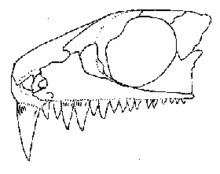Extinction status Extinct Rank Genus | Class Reptilia Phylum Chordata | |
 | ||
Similar Australothyris, Bolosaurus, Bolosauridae | ||
Colobomycter is an extinct genus of small parareptile known from the Early Permian of Oklahoma. The genus was first described from fossil remains in 1958, at which time it was believed to represent a synapsid, specifically, a pelycosaur. However, the discovery of new material and reexamination of the holotype led to its reclassification as a member of the Eureptilia. More recent studies indicate that Colobomycter is properly placed within the amniote clade Parareptilia, closely related to the taxon Acleistorhinus. Together, the two taxa form the Family Acleistorhinidae.
No postcranial material is known for Colobomycter, and the skull material referred to the genus (representing four individuals) has all been recovered from a single locality, the Dolese Brothers Quarry, near Richard's Spur, 11 kilometers north of Fort Sill, Comanche County, Oklahoma, dating to the early Kungurian stage. This site comprises a fissure-fill deposit yielding a unique upland fauna. Other taxa recovered from these strata preserves a wide array of tetrapods, including lepospondyl and temnospondyl amphibians, the anthracosaur Seymouria, microsaurs, captorhinomorphs, protorothyridids, and synapsids.
The skull of Colobomycter is considered one of the most enigmatic found in any of the parareptiles primarily due to the presence of greatly enlarged caniniform teeth possessing serrated edges in the premaxilla and, to a lesser extent, the maxilla. The length of the premaxillary fang is greater than half the height of the skull. Modesto et Reisz (2008) note that "The large size of the first premaxillary tooth is [otherwise] unheard of among early reptiles." The taxon also possesses unusual "folding" of the dentine at the bases of its larger marginal teeth, a state known as polyplycodont (a condition also seen to have evolved independently in diadectomorphs, ichthyosaurs, and mosasaurs). Modesto et Reisz (2008, p. 682) speculate that hard-shelled insects and other arthropods may have formed the bulk of its diet, but that Colobomycter could also have fed on vertebrates, including small amphibians and eureptiles. It is notable as the smallest predatory amniote from the Richard's Spur deposits, with a skull measuring a mere 70-80 millimeters in length.
